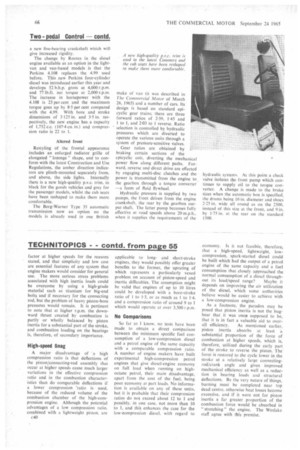Two-pedal Control Option on Latest Commer 15 cwt.
Page 67

Page 68

If you've noticed an error in this article please click here to report it so we can fix it.
MORE POWER FOR COMMER 1500 AND 2500 MODELS
rFIANGES to the petrol and diesel engines specified in the Commer 1500 and 2500, 15-cwt. and 1-ton models have been announced this week by the Rootes Group. At the same time improved interior trim and seating have been incorporated and the Borg-Warner Type 35 automatic transmission has been introduced as an option on the 1500 model. The 1500 and 2500 Series are made in a wide variety of versions. including vans, pick-ups, and with 11to 14-seat passenger bodies, and no change is made in the body style availability.
The petrol engine now specified for the 1500 and 2500 is the 4P.105 four-cylinder unit as used in the revised Rootes cars announced on September 8. A maximum gross output of 62 b.h.p. is developed at 4,000 r.p.m. by this 1,724 c.c. (105 cu. in.) engine and maximum net torque is 90 lb.ft. at 2,000 r.p.m.
In design, the unit follows the 1.592 c.c. engine it supersedes; the stroke has been increased to 3-25 in., whilst the bore of 3-21 in. remains the same. The cylinder block has been enlarged to accommodate a sew five-hearing crankshaft which will give increased rigidity. The change by Rootes in the diesel engine available as an option in the lightvan and van-based models is that the Perkins 4.108 replaces the 4.99 used before. This new Perkins four-cylinder diesel was introduced earlier this year and develops 52 b.h.p. gross at 4,000 r.p.m. and 77 lb.ft. net torque at 2,000 r.p.m. The increase in horsepower with the 4.108 is 23 per cent and the maximum torque goes up by 8-5 per cent compared with the 4.99. With bore and stroke dimensions of 3.125 in. and 3-5 in. respectively, the new engine has a capacity of 1,752 cc. (107.4 Cu. in.) and compression ratio is 22 to 1.
Altered front Restyling of the frontal appearance includes an enlarged radiator grille of elongated " lozenge " shape, and to conform with the latest Construction and Use Regulations, the amber direction indicators are plinth-mounted separately from, and above, the side lights. Internally there is a new high-quality p.v.c. trim, in black for the goods vehicles and grey for the passenger models, whilst the cab seats have been reshaped to make them more comfortable.
The Borg-Warner Type 35 automatic transmission now an option on the models is already used in one British make of van (it was described in The Commercial Motor of March 26, 1965) and a number of cars. Its design is based on standard epicyclic gear trains; there are three forward ratios of 2.39, 1.45 and 1 to 1, and 2.03 to 1 reverse. Ratio selection is controlled by hydraulic pressures which are diverted to operate the various units through a system of pressure-sensitive valves.
Gear ratios are obtained by braking certain sections of the epicyclic unit, diverting the mechanical power flow along different paths. Forward, reverse and direct drive are effected by engaging multi-disc clutches and the power is transmitted from the engine to the gearbox through a torque converter —a form of fluid flywheel.
Hydraulic pressure is supplied by two pumps. the front driven from the engine crankshaft, the rear by the gearbox output shaft. The latter pump becomes fully effective at road speeds above 20 m.p.h., when it supplies the requirements of the hydraulic systems. At this point a check valve isolates the front pump which continues to supply oil to the torque converter. A change is made to the brake sizes when the automatic box is specified, the drums being 10 in. diameter and shoes 2-25 in. wide all round as on the 2500. instead of this size at the front, and 9 in. by 1-75 in. at thc rear on the standard 1500.
























































































































